Community Tip - Did you know you can set a signature that will be added to all your posts? Set it here! X
- Community
- Creo+ and Creo Parametric
- 3D Part & Assembly Design
- Cylinder mechanism in lybrary
- Subscribe to RSS Feed
- Mark Topic as New
- Mark Topic as Read
- Float this Topic for Current User
- Bookmark
- Subscribe
- Mute
- Printer Friendly Page
Cylinder mechanism in lybrary
- Mark as New
- Bookmark
- Subscribe
- Mute
- Subscribe to RSS Feed
- Permalink
- Notify Moderator
Cylinder mechanism in lybrary
Hi Guys,
we are using Creo 3.0 M070 without Windchill.
We are working with 7 engineers together on a server and we do have a library with normparts in it (such as bolts, pneumatic cylinders, gears,...).
In the past we haven't used the mechanism functionality of Creo yet (don't ask me why).
Now we want to start using the mechanism functionality and we had a nice training for it yesterday.
We do have a lot of cylinders in our Library which have to be modified to mechanisms. This is no problem, but I think we will have some other problems (and the guy who was training us, couldn't help us with it):
1. We don't want to have the Enable Regeneration Value checked on, because otherwise all cylinders in our machines will be in the IN-position again when you do a regeneration.
And we want to stay them in the position as they are.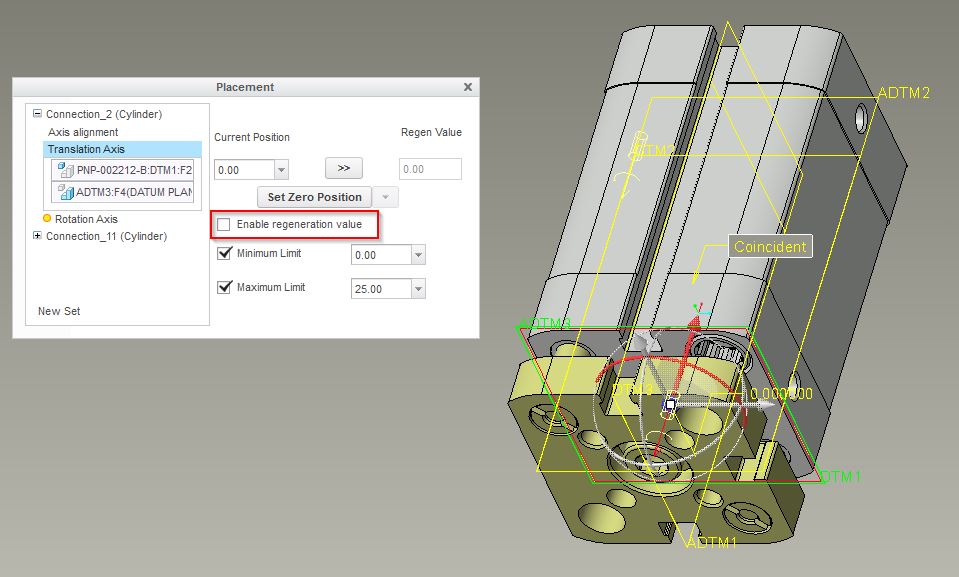
I don't think this will be a problem...
But this means that when we drag the cylinder-position just a bit and push SAVE, the assembly will be saved over and over again in the library:

This will be a problem when at least 2 engineers will have the same cylinder in session at the same moment...
Can anyone tell me how to solve this. Maybe there a parameter to be switched off...
We don't want to make a local copy of the cylinder in each project, because that will kill the advantages of our library...
2. We can make some snapshots of the cylinder-assembly, let's say the IN and OUT position and maybe some extra fixed positions:
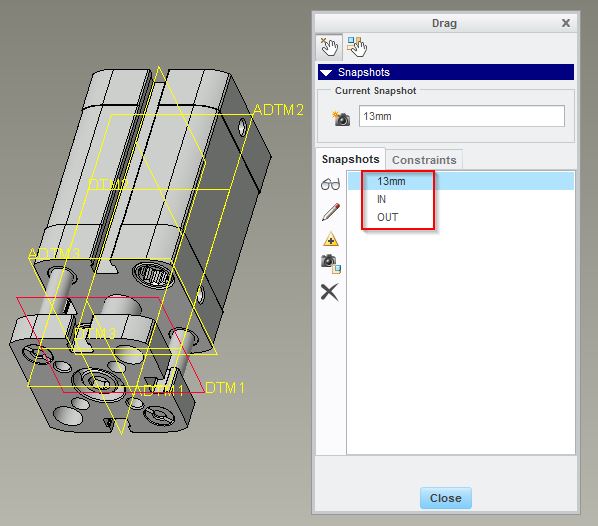
And we can borrow these snapshots in a higher level assembly:
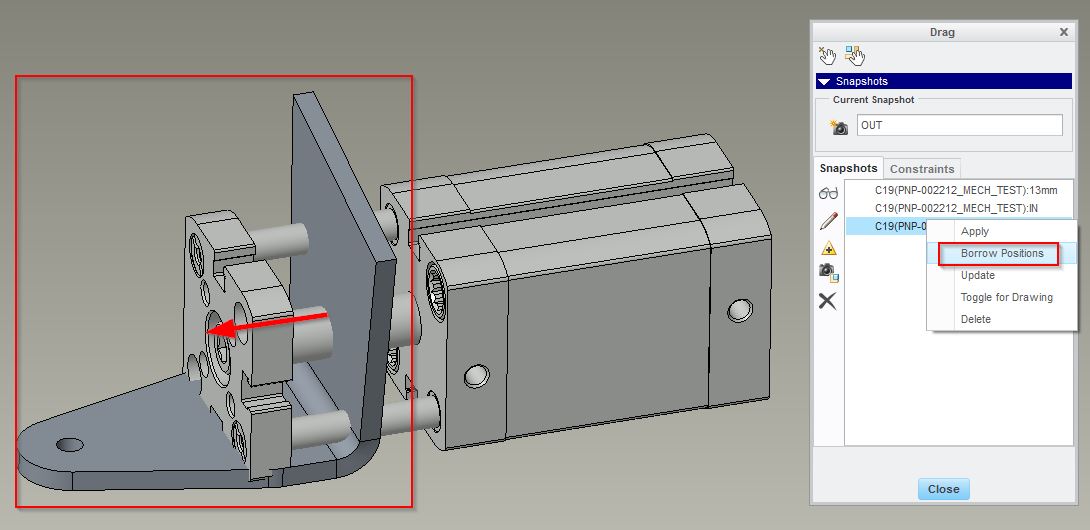
But the problem is that the parts which are assembled on the cylinder aren't following the cylinder position (without doing a regeneration).
Is there somebody who knows how to solve this?
Thanks for the help guys!
This thread is inactive and closed by the PTC Community Management Team. If you would like to provide a reply and re-open this thread, please notify the moderator and reference the thread. You may also use "Start a topic" button to ask a new question. Please be sure to include what version of the PTC product you are using so another community member knowledgeable about your version may be able to assist.
- Labels:
-
Assembly Design
- Mark as New
- Bookmark
- Subscribe
- Mute
- Subscribe to RSS Feed
- Permalink
- Notify Moderator
I really have to dispute your 1st point:
1. We don't want to have the Enable Regeneration Value checked on, because otherwise all cylinders in our machines will be in the IN-position again when you do a regeneration.
- only true if you assemble them "as-is". But if you assemble them as "flexible component" then you can vary what is the "default position" of each instance...
So, these cylinders are actuators, or "drivers" of your assembly motion, you should have the "Enable regeneration value" checked ON.
Furthermore, I would suggest that when you are preparing these library components, name this dimension and prescribe it as flexible prior to storing the cylinder in your library. This will save you and your users from a lot of work and confusion.
Step 1) define the regeneration value to create a dimension that will be "flexible"
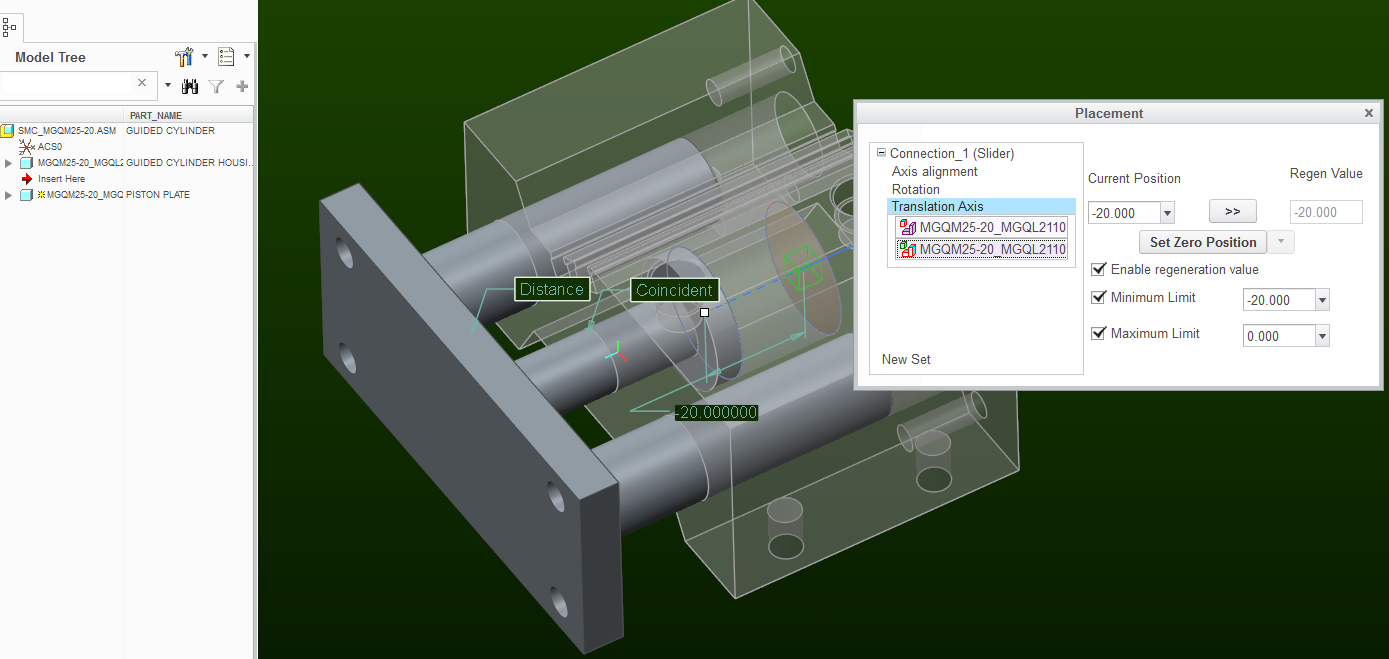
Note: I sometimes find definition of "motion limits" in the mechanism joint connection definition a bit wonky when Creo insists of using negative values for direction of travel that I consider to be positive. There is no option to "flip" the direction, so in the above case, we have the limit of the movement from -20 to 0 (-20 being the "extended" position). But I find that afterwards, I have use positive numbers to specify the extension distance! The gotcha is that if you leave your regeneration value at "0": When you assemble such flexible component into another assembly, you will get a regeneration failure because for the inserted instance, the "flexed" distance will have a negative sign! Anyway, hard to explain and very confusing, but I work around that by putting away cylinders with such negative limits in their 1/2 position - in this case, -20mm. Then this is inserted into the assembly, the default position will be extended, but you will not have the regeneration failure.
Step 2) Rename this dimension by editing it's properties. No one will remember what d1 means.
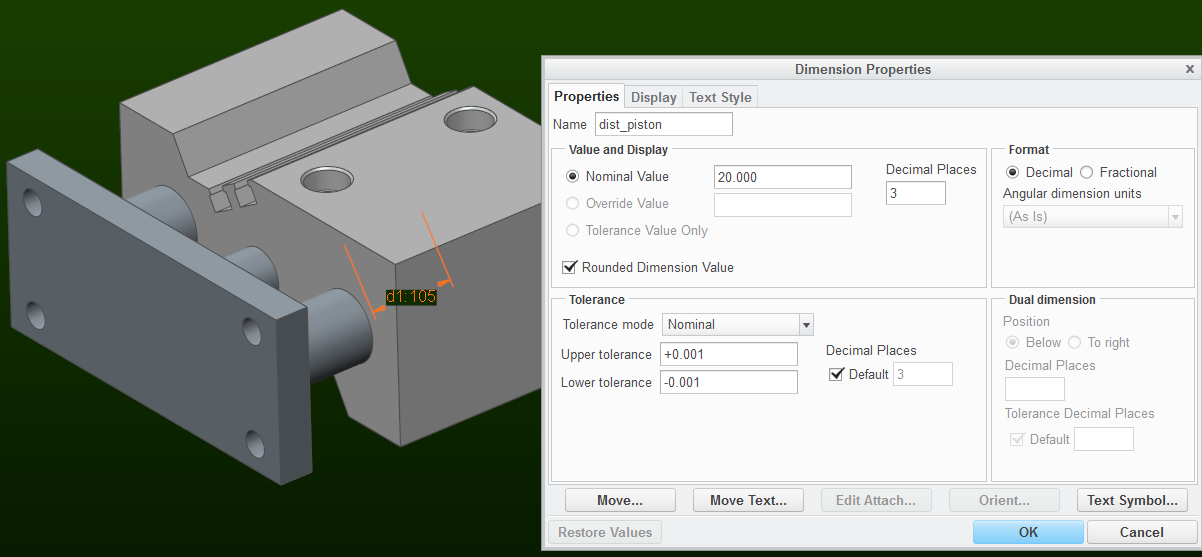
Step 3) Edit the model's properties and prescribe the flexiblity:
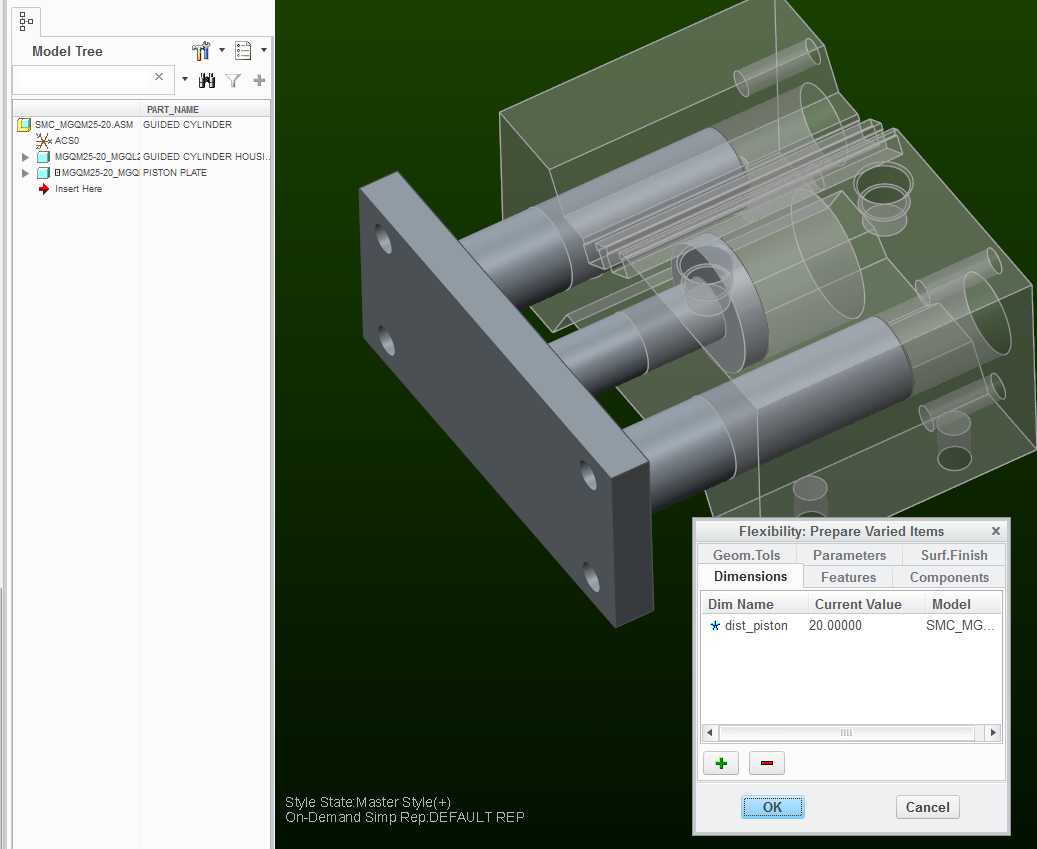
Tip: use query-select to get at this "C"omponent level dimension.
- Mark as New
- Bookmark
- Subscribe
- Mute
- Subscribe to RSS Feed
- Permalink
- Notify Moderator
The FLIP Connection is in the dashboard header and not on the placement tab.
- Mark as New
- Bookmark
- Subscribe
- Mute
- Subscribe to RSS Feed
- Permalink
- Notify Moderator
Ah, ok!, thanks a lot. Not sure how I missed that button all these years ![]()
- Mark as New
- Bookmark
- Subscribe
- Mute
- Subscribe to RSS Feed
- Permalink
- Notify Moderator
Hi Paul,
thanks for your answers. But unfortunately I'm not able to make this dimension flexible, because the dimension doesn't appear when I'm in the "Flexibility" window:
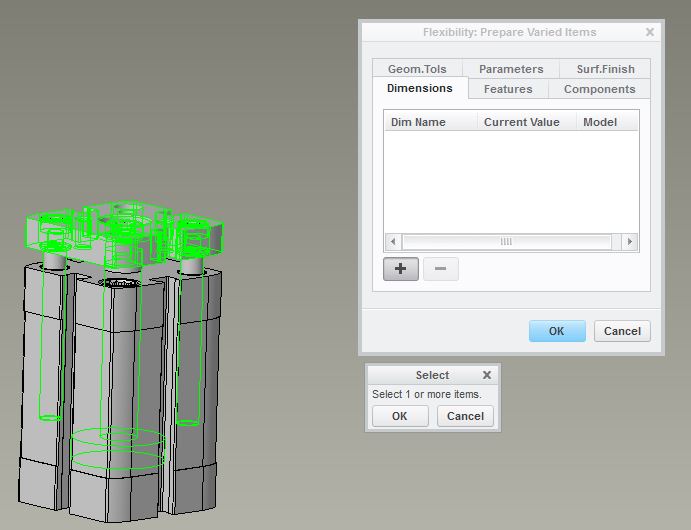
You were talking about the query-select, but I don't know how to do this...
- Mark as New
- Bookmark
- Subscribe
- Mute
- Subscribe to RSS Feed
- Permalink
- Notify Moderator
Ah, yes that dimension is not easy to get to in the usual way.
What I usually do is query select the component. Then its placement dimensions will show up.
Query-select is done by quick right-clicking, then left-clicking on the component. Then a "Pick From List" appears and you can select an item from this list.
Another way to get the query-select is to do a long right-click; a menu that pops up, select "Query" then left-click on the component:

The important thing is to pick the component (a item in the list that begins with C), not some feature of the component (F line). So in the screenshot above, that would be the 2nd line in the list.
Also, there is a way of getting the dimension selected using the Search Tool. When you press the green + button and are prompted with the "Select 1 or more items" dialog box, press CTRL+F. The Look for "Dimension" and Look by: "Dimension" should be selected in the Search Tool. Click on the "Find Now" button and the assembly dimensions will show up. You then select it in the "found" list and transfer it to the "selected" list with the >> button.
- Mark as New
- Bookmark
- Subscribe
- Mute
- Subscribe to RSS Feed
- Permalink
- Notify Moderator
The last way with CTRL+F works fine.
But the way with query select doesn't seam to work, or isn't really clear for me.
But this flexibility is a great way to work with, because indeed it isn't saving the cylinder every time again.
About the second problem (borrowing the snapshots): is there anyone who is having a solution for this?
Thanks!
- Mark as New
- Bookmark
- Subscribe
- Mute
- Subscribe to RSS Feed
- Permalink
- Notify Moderator
Well, I think I don't know much about snapshots. I usually only made them "for drawing" to easily show the mechanism in different configurations.
But it seems that if you have a joint with "enabled regeneration value" in your mechanism, then it will override the snapshot upon regeneration.
That's fine with me because I usually work by editing the "flexible" dimensions of the moving components to get the the assembly to the configuration in which I want it to regenerate.
But if you are used to working with snapshots to capture the configuration, then you probably shouldn't use the enabled regeneration value. You can still assemble your cylinders as "flexible" in order to prevent the library model from being overwritten.
It would be handy to have the assembly auto-update after component snapshots are "borrowed", but I think you have to regenerate to update the model to the "borrowed positions". It's strange because when you use the "Motion axis constraints" then the assembly updates immediately after you specify each joint value:

- Mark as New
- Bookmark
- Subscribe
- Mute
- Subscribe to RSS Feed
- Permalink
- Notify Moderator
One additional comment. You really should change the permission on your library folder so that it's read only. You don't want people accidentally saving changes to library models. This can cause tremendous problems with all the existing assemblies that depend on these library models.





